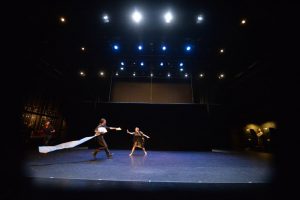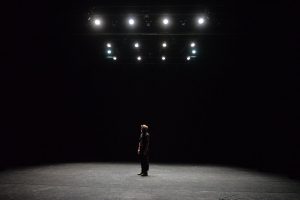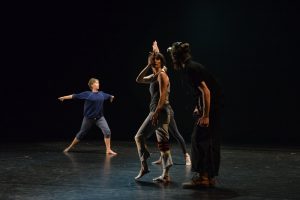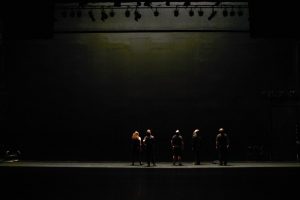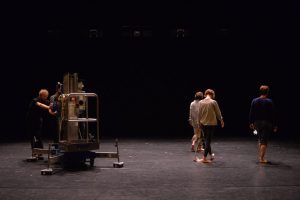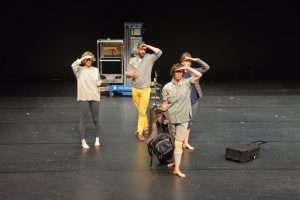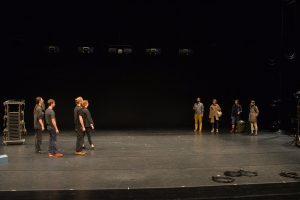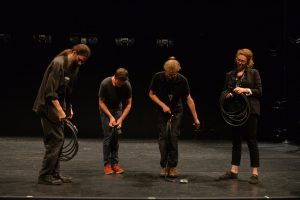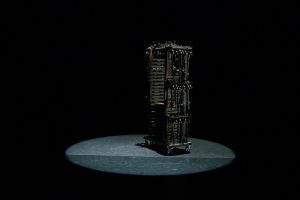SOFT GOODS’ SMOOTH SELL
Karen Sherman’s Soft Goods presents the audience with a new perspective on dance by focusing on what happens behind the curtain. The show is set up like a play that explores the stagehands’ job, the dancers’ rehearsals and the less-than-pleasant interactions between the two groups as they come together to create a cohesive production. Their complicated relationship shines a light on the invisible foundation they form and how it elevates both sides into artists of equal standing.
Viewers entered UCLA’s Freud Playhouse, after the sceneshifters (Andy Kedl, Zachary Humes, Ross Orenstein and Emily McGillicuddy) had already begun winding cords and jabbering about their jobs as if cleaning up after a show. Soft Goods’ casual dialogue felt authentic, lifted straight out of interactions Sherman could have had while working as a technician herself — a fact mentioned in the program as her creation’s main driving force.
Their laid back approach to work provided a direct contrast to the appearance of three dancers (played by Joanna Furnans, Krista Langberg and Jessica Cressey) whose introduction established tension between them and the crew. Realistic acting was briefly suspended as the two groups began wordlessly taking turns slapping one another, pinpointing their frustrations into a reaction that brought their internal emotions and desires to the surface. A few gasps from the audience later and the performers had casually moved on from the scene just as quickly as they had started it. They created an uncomfortable feeling that lingered as their antagonism evolved into a form of passive aggressiveness that lasted throughout the rest of the performance.
Sherman’s production paid heavy attention to detail through its incorporation of professional tools and machines used by the crew, such as the cherry picker. Its complexity served as a visual aid that showcased the groups’ similarities and differences. The technicians’ reliance on the electrical ladder for doing their job contrasted them with the contemporary performers who only used their bodies to convey their art. However, watching the crew lift themselves in the air to fiddle with cables and physically create space between themselves and their workplace rivals made them look empowered and incorporated their movements into a dance — the main routine to concentrate on for at least half of the show.
The dancers’ performances were never fully seen from the perspective of an audience member enjoying a completed production. There was a bigger emphasis on their role in rehearsal, which provided Soft Goods with a lighter, funny side to their characters after the slapping scene presented them as potentially snobby artists overtly aware of their vitality to a show. Once they began running their routine, the dancers were seen reminiscing about old techniques that took them back to basics, forming natural shapes such as trees. Their newfound charm was constantly interrupted by critiques delivered over an intercom by the unseen director and choreographer. Their instructions restricted the disappointed dancers’ free-flowing movements to a more stagnant piece finally performed in pieces to Yoko Ono’s “Nobody Sees Me Like You Do.” They became like the stagehands — workers following instructions for the sake of fulfilling someone else’s vision.
The formula continued throughout the rest of the work with more moments of acted practices blending in and out of traditional stage performances enhanced by Carrie Wood’s side and overhead mood lighting. Electric colors enhanced the energy in some segments and soft yellows offered moments of introspection and self-realization. Transitions were seamless.
A climactic final scene put a spin on the show’s backstage point of view by using a scrim to completely block out the completed, final piece all parties had been presumably preparing for. Rather than allowing glimpses of the routine like in earlier scenes, it was shut out entirely as the audience’s perspective remained with the crew. As Philip Glass’s “Dance IX” played, props were flung over the divider. No explanation was given about the events taking place on the other side, letting imaginations run wild with intrigue before attention was diverted back to the saucy run-ins between the stressed-out parties. Both were ruled with anxiety as technicians scrambled to gather the fallen objects and return them to the flustered dancers eager to get back to their performance.
The piece ended with bright purple and pink lights and a smoke machine that shot its contents over the viewers as electric guitars blared overhead. The white plumes wafted almost all the way to the theater’s back wall. Surprising and confusing, but pleasant all at once, the effect was a bit disconnected from the dark humor that had taken place on stage, but left everyone watching in a relatively good mood as cheers promptly led to a sudden, but charming exit. It added an element of fun to the show, as a reminder of how exciting it is to be a part of a production as well.
Overall, Sherman did a good job of marrying and sharing her two worlds. She never belittled either group’s roles by making one’s contribution seem more vital than the other’s, but instead justified the importance of both. Their work was constant and the soft goods they created fleeting, but the feelings they inspired remained long after the curtain closed.
photos by Sean Smuda and Gene Pittman/Walker Art Center
Karen Sherman
Soft Goods
presented by UCLA’s Center for the Art of Performance
Freud Playhouse at Macgowen Hall
played October 7, 2017 at 8
for future events, call 310-825-2101 or visit CAP UCLA
for more info, visit Karen Sherman

